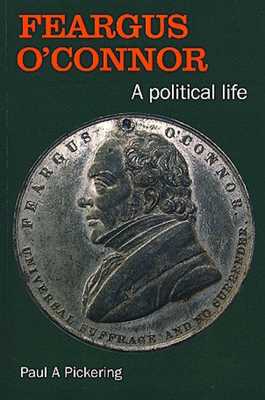Fergus O'Connor: a political life
Peter Berresford Ellis reviews Feargus O'Connor: a political life by Paul A. Pickering,(Chartist Studies Series No 9), Merlin Press, ISBN 0850365619, £14.95 pbk

ONE OF the saddest splits in English working-class history was when two Irishmen fell out with one another. I refer, of course, to the bitter conflict between the Chartist leaders Feargus O'Connor and James Bronterre O'Brien.
O'Connor was a curious candidate for a working class leader. He claimed royal descent from the Kings of Connacht who provided the last High King of Ireland who agreed the Treaty of Windsor with Henry II, accepting Ireland as part of the Angevin Empire.
Born at Connorville, Co. Cork, in 1794, educated at Portarlington grammar school and TCD, he was called to the Irish Bar and became an MP in 1832, joining Daniel O'Connell's Repeal movement. On losing his seat he went to England and became involved with working-class radical politics, founding The Northern Star and becoming one of the best known of the Chartist leaders.
O'Brien was born in 1805 in Co Longford, educated at Edgesworthstown school TCD and Gray's Inn in London. He became involved with the Chartists but his articles and speeches were revolutionary from the start. In 1840 he was sentenced to imprisonment for sedition.
O'Connor had upset fellow Chartists, taking no part in the Newport `rising' and while seeming to preach `revolution' expressing no clear policies on it or radical reform. His`National Land Company' to re-settle urban workers on smallholdings, which nearly bankrupted the movement, was dreadfully impractical. Opposition from O'Brien to the scheme was the cause of the bitter argument between them. O'Connor's ill-prepared petition at the Chartist meeting of 1848 saw the death knell of the movement.
O'Connor's egocentricity, which had caused the alienation of many Chartist leaders other than O'Brien, developed into insanity and he ended his days in a private asylum in London in 1855, believing he was a `state prisoner', as his father, a United Irishman, had been.
O'Brien eked out a living with his writing and lecturing, refusing to give up any of his radical revolutionary ideas, and died in great poverty in London in 1864.
Had O'Connor been able to suppress his egocentricity and dictatorial methods and work with O'Brien and the other more far-sighted leaders, then the Chartist movement might have achieved great advances for the working class movement not only in Britain but also in Ireland. The current book, sadly, mentions O'Brien only twice and does not really explain the nub of the contention between them.
It has been argued that the conflict between reform and revolution was the cause of the O'Connor-O'Brien schism. It does seem one of those interesting points of contention that always held back a united working class movement in the 19th century.
The disagreements between William Thompson of Cork, who stood for revolution, and the Welsh reformer Robert Owen is an example. Owen wrote to Thompson:
"While you are boldly operating on the whole mass, I am endeavouring to arrange a little part of the social machine, not forgetting its connection with the whole."
However, I think, and it comes over in this study, that the real problem was that O'Connor did not really know what path to take - reform or revolution. In the end he vacillated and alienated his supporters.
The work is more obviously concerned with studying the positive side of O'Connor's career and trying to evaluate his role in bringing `working Saxon and Celt' together in a common struggle.
The author believes that O'Connor, more than any other popular leader of his generation, sought that goal. Alas, many an Irish leader, both before and since, has seen, it was a hopeless task. To paraphrase Connolly's comment about the English socialists made just before his execution - they would never understand his role in the Irish independence movement. But, as one of the Chartist Studies Series (no 9) produced by Merlin Press, Pickering's study is well worth reading.
Connolly Association, c/o RMT, Unity House, 39 Chalton Street, London, NW1 1JD
Copyright © 2009 Peter Berresford Ellis

